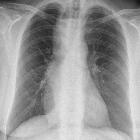chagas disease
Chagas disease, also known as American trypanosomiasis (plural: trypanosomiases), is a tropical parasitic infection with a wide spectrum of clinical manifestations since it can virtually affect any organ, but there are characteristic radiological features.
Epidemiology
Chagas disease is endemic to Central and South America. An estimated 24 million people are infected with 60,000 deaths each year attributed to this infection .
Clinical presentation
Cardiac manifestations
Cardiac sequelae are common in endemic regions. The pathogenesis is unclear since the parasite is not often found in heart tissue on autopsy, and immunologic myocarditis has been suggested as the origin.
Symptoms begin with acute myocarditis, after which patients enter a latent phase. Approximately 20% of these patients experience gradual fibrous replacement of myofibrils and Purkinje fibers. Eventually, dilated cardiomyopathy ensues, with arrhythmias and heart block. Segmental wall motion abnormalities and apical aneurysm may occur. Heart transplantation has been performed for end-stage disease .
Gastrointestinal manifestations
10-15% of patients are affected by chronic infection, and manifestations include:
- esophageal dysmotility and megaesophagus
- megaduodenum and small bowel dilatation
- megacolon with left colon and rectosigmoid more commonly affected
Genitourinary manifestations
Chagas disease is also known to cause dilatation of the ureter.
CNS manifestations
- meningoencephalitis
- chagoma
- in immunocompromised patients
Pathology
Chagas disease is caused by the protozoan Trypanosoma cruzi. It is commonly transmitted to humans by an insect vector.
Radiographic features
Radiographic features of Chagas disease can be seen on plain films, contrast studies, echocardiography, CT and MRI.
MRI
On cardiac MR, delayed enhancement has been reported in the left ventricular wall in both CAD and non-CAD distributions. The delayed enhancement is progressive over time, and increasing delayed enhancement corresponds with decreasing cardiac performance .
Echocardiography
- acute Chagas cardiomyopathy
- pericardial effusion
- may be moderate to severe
- may, rarely, precipitate cardiac tamponade
- normal systolic and diastolic function
- some may have regional systolic dysfunction affecting the apical and anterior segments
- pericardial effusion
- chronic Chagas cardiomyopathy
- may present with an idiopathic dilated cardiomyopathy phenotype
- regional wall motion abnormalities
- basal inferior segment most commonly affected
- left ventricular apical aneurysms
- small subset have right ventricular apical aneurysms
- diastolic dysfunction
- degree correlates with symptomatology
- asymptomatic patients may have grade I (impaired relaxation) dysfunction
- severely symptomatic patients often demonstrate an irreversible restrictive (grade III) pattern
- degree correlates with symptomatology
History and etymology
Named after Carlos Justiniano Ribeiro Chagas (1879-1934), a Brazilian physician who completely described this infectious disease: the pathogen, the vector, the host, the clinical manifestations and its epidemiology .
Differential diagnosis
- for esophageal disease: achalasia
Siehe auch:
und weiter:

 Assoziationen und Differentialdiagnosen zu chagas disease:
Assoziationen und Differentialdiagnosen zu chagas disease:
